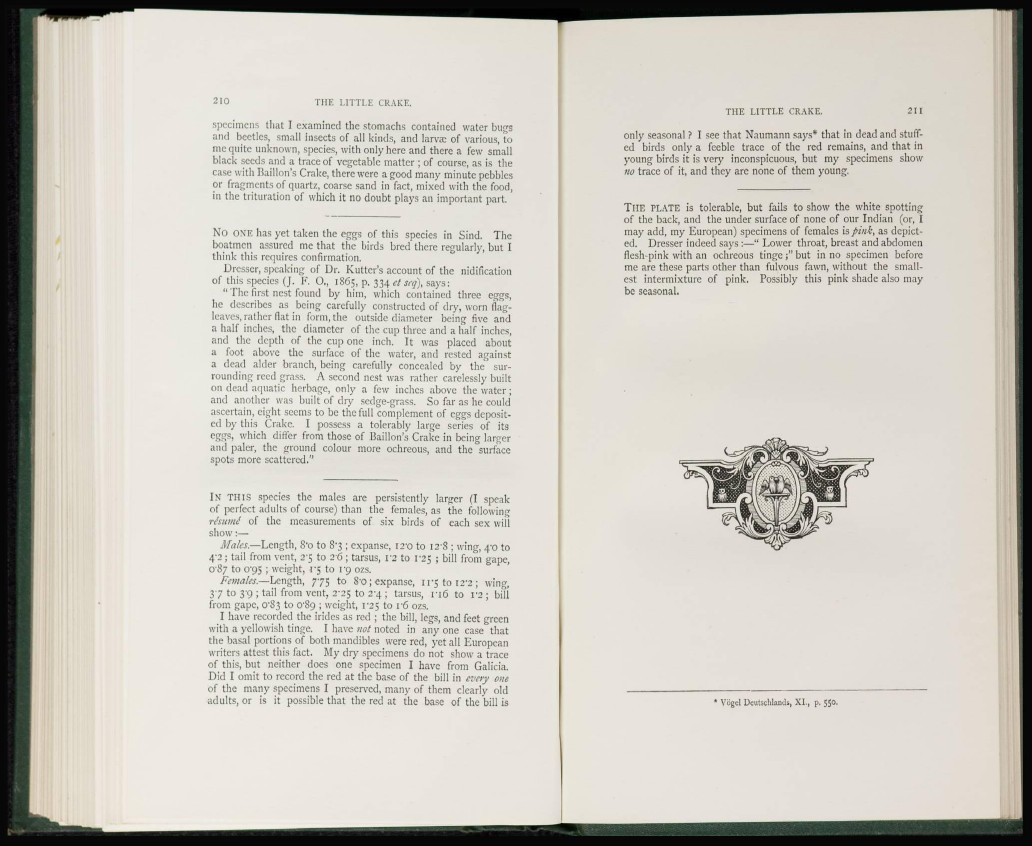
210 THE LITTLE CRAKE.
specimens that I examined the stomachs contained water bugs
and beetles, small Insects of all kinds, and larva? of various, to
me quite unknown, species, with only here and there a few small
black seeds and a trace of vegetable matter ; of course, as is the
case with Baillon's Crake, there were a good many minute pebbles
or fragments of quartz, coarse sand in fact, mixed with the food,
in the trituration of which it no doubt plays an important part.
No ONE has yet taken the eggs of this species in Sind. The
boatmen assured me that the birds bred there regularly, but I
think this requires confirmation.
Dresser, speaking of Dr. Kuttcr's account of the nidification
of this species (J. F. O., 1865, p. 334 el seq), says:
" The first nest found by him, which contained three eggs,
he describes as being carefully constructed of dry, worn flagleaves,
rather flat in form, the outside diameter being five and
a half inches, the diameter of the cup three and a half inches,
and the depth of the cup one inch. It was placed about
a foot above the surface of the water, and rested against
a dead alder branch, being carefully concealed by the surrounding
reed grass. A second nest was rather carelessly built
on dead aquatic herbage, only a few inches above the water ;
and another was built of dry sedge-grass. So far as he could
ascertain, eight seems to be the full complement of eggs deposited
by this Crake. I possess a tolerably large series of its
eggs, which differ from those of Baillon's Crake in being larger
and paler, the ground colour more ochreous, and the surface
spots more scattered."
IN THIS species the males are persistently larger (I speak
of perfect adults of course) than the females, as the following
résumé of the measurements of six birds of each sex will
show :—
Males.—Length, 8'o to 8'3 ; expanse, I 2 ' 0 to 128 ; wing, 4'0 to
4-2 ; tail from vent, 2'5 to 26 ; tarsus, 12 to 1*25 ; bill from gape,
087 to o'95 ; weight, i-5 to i'9 ozs.
Females.—Length, 775 to S'o ; expanse, H'5toi2-2; wing,
37 to 3'9 ; tail from vent, 2'25 to 2-4 ; tarsus, r i 6 to i'2 ; bill
from gape, 0S3 to 0S9 ; weight, 1*25 to i"6 ozs.
I have recorded the irides as red ; the bill, legs, and feet green
with a yellowish tinge. I have not noted in any one case that
the basal portions of both mandibles were red, yet all European
writers attest this fact. My dry specimens do not show a trace
of this, but neither does one specimen I have from Galicia.
Did I omit to record the red at the base of the bill in every one
of the many specimens I preserved, many of them clearly old
adults, or is it possible that the red at the base of the bill is
only seasonal ? I see that Naumann says* that in dead and stuffed
birds only a feeble trace of the red remains, and that in
young birds it is very inconspicuous, but my specimens show
no trace of it, and they are none of them young.
THE PLATE is tolerable, but fails to show the white spotting
of the back, and the under surface of none of our Indian (or, I
may add, my European) specimens of females is pink, as depicted.
Dresser indeed says :—" Lower throat, breast and abdomen
flesh-pink with an ochreous tinge ;" but in no specimen before
me are these parts other than fulvous fawn, without the smallest
intermixture of pink. Possibly this pink shade also may
be seasonal.
* Vbgel Deutsclilands, XL, p. 550.